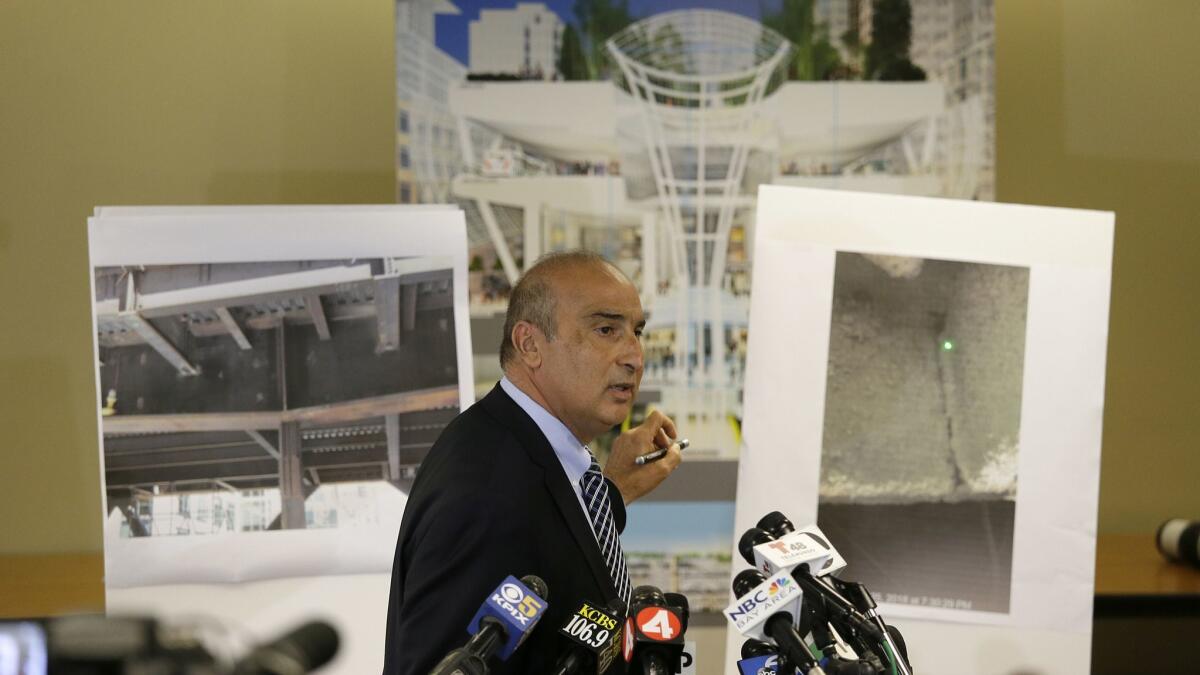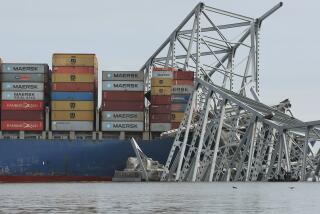Anger, questions after $2.2-billion S.F. bus center closed by cracked beams

It cost $2.2 billion and took 10 years to build. At its opening this summer, officials hailed the Salesforce Transit Center as a hub of the new San Francisco, part of a crop of new towers that are reshaping the city’s skyline.
But on Wednesday, the bus depot remained closed after crews found cracks in two steel beams. The discovery alarmed and outraged citizens, and officials had few answers about what caused the problem and when the center would reopen.
For the record:
9:15 a.m. Oct. 1, 2018This article misspells the last name of San Francisco commuter Sonya Kendall Heisters as Heister.
Transbay Joint Powers Authority Executive Director Mark Zabaneh told reporters Wednesday afternoon that inspectors were called in about 10 a.m. the previous day, when crews found a crack in the fireproofing of a steel beam. Six hours later, officials closed the transportation center, which opened in August, and it will remain closed until at least the end of next week.
Inspectors later found a second fractured beam. The biggest of the two cracks is more than 2 feet long, Zabaneh said.
The center is structurally safe, Zabaneh insisted, adding that Fremont Street — the road under where the cracked beams are located — and the building were closed out of an abundance of caution. He added that the cracks are a localized issue and not present in any other part of the building.
The closure marks another hit to San Francisco’s image. The city is already dealing with the nearby Millennium Tower, which has sunk since construction began in 2006 and is tilting. Despite the leaning of the building, city-appointed experts have concluded that the sinking has “not compromised the building’s ability to resist strong earthquakes.” But the building has become the butt of jokes and an unlikely tourist attraction.
The transit center also sits not far from the new $1-billion Salesforce Tower, which dwarfs any other skyscraper in the city. Salesforce bought naming rights to the transit center in 2017 as part of a 25-year, $110-million sponsorship agreement.
Planners hope the transit center will eventually connect to Caltrain service to the Silicon Valley, making it an essential hub for Bay Area commuters. It opened to cheers despite cost overruns.
Officials said they plan to add vertical support columns to the building, which would allow them to reopen Fremont Street below.
“We’re taking every measure we can to rectify the issue,” Zabaneh said. “We need to focus our attention on fixing the beam and then finding out what caused” the crack.
San Francisco Mayor London Breed demanded “a thorough and transparent investigation to determine the causes, severity and impacts of this discovery, as well as a plan to reopen the transit center as soon as it is safe to do so.”
Abolhassan Astaneh, a professor emeritus in civil engineering at UC Berkeley, said he thinks the problem is one of three issues: The rooftop park is too heavy, there was a problem with the welding of the beams, or there was a flaw in the manufacturing. The steel came from Stockton-based Herrick Corp.
If it is a welding issue, it would be unlikely that two beams would be affected, he said. And flaws in fabrication are rare. Although he hesitated to speculate, Astaneh said the more likely problem is the weight on top of the building.
He commended the Transbay Joint Powers Authority for closing the entire building.
“That’s very important because it showed me that they did their job,” he said, adding that implementing a temporary solution before opening the building would be reasonable.
The closure created a commuter nightmare.
There was already an influx of more than 100,000 visitors for the annual Salesforce conference, Dreamforce. As angry commuters were turned away from the transportation center, the tech company’s CEO, Marc Benioff, was giving his keynote speech at the event. And it was his birthday.
Commuters expressed fatigue with the city’s seemingly never-ending transportation troubles as well as with what they called rapid development at the expense of the community’s needs.
“From what I’ve heard, [buildings] go up fast because the tech industry is growing really fast and they want to have their offices here … [when] it’s not a great place to actually build,” said Oakland resident Sohail Kamdar.
“It’s the difference between wanting to build for the future and wanting to build in the most profitable way.”
While commuters directed to a temporary terminal waited in long lines and complained about the lack of clear instructions, Kamdar walked to an overcrowded BART station that was taking a hit from the closure. He was delayed about 15 minutes, an unusually long time for his commute.
Three months pregnant, wearing high heels and carrying a backpack full of work essentials, Sonya Kendall Heister made her usual afternoon dash Tuesday from San Francisco’s financial district toward the transit center.
Then a transportation official turned her away.
“There was this mad scramble,” she said. “Sidewalks were taken over by people moving en masse to the other terminal in a state of frustrated confusion.”
Heister, on her way from the Embarcadero to her home in the East Bay, had to make arrangements for her 4-year-old to be picked up from school. As she looked around her crowded bus, she saw a couple make a similar call.
She was exhausted. In eight years of commuting to downtown San Francisco, she said she has seen her share of transportation debacles. This was another to add to the books.
“There’s all sorts of adventures in commuter-land in the Bay Area,” she said. “But I think there was a lot of optimism among riders for the new terminal.”
The Associated Press contributed to this report.
More to Read
Start your day right
Sign up for Essential California for news, features and recommendations from the L.A. Times and beyond in your inbox six days a week.
You may occasionally receive promotional content from the Los Angeles Times.







